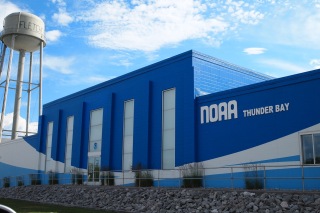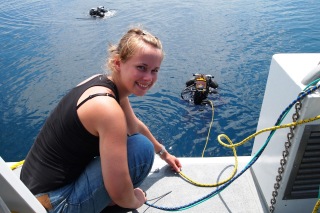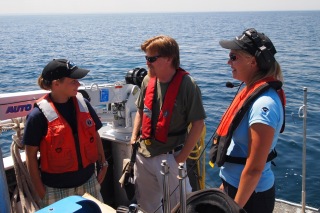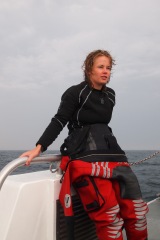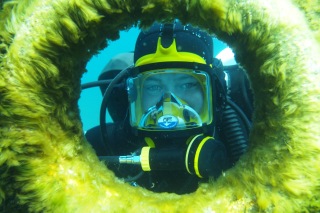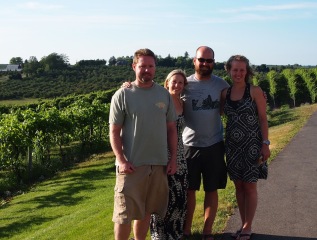The Great Lakes that is. I met with Joe Hoyt, the 2004 North American Rolex Scholar, in Richmond, Virginia – ready for the 18 hour drive up to Alpena, Michigan. It is intriguing how fast one get to know each other when you are stuck in a car, and even though it was a loooong drive, I will miss your stories, Joe. We finally arrived Casa Casserley, Joe´s friend and colleague, Tane Casserley, was hosting us for the week, and a couple of hours later Lauren Heesemann, a research coordinator with NOAA, arrived and our group was complete.
Alpena, Michigan is a city. It is not a town. It is not a village. Even though it might appear as one. A sweet one of course. It is situated right next to Lake Huron, and there you will find Thunder Bay National Marine Sanctuary, administered by the National Oceanic and Atmospheric Administration (NOAA).
Joe is a maritime archaeologist with NOAA, and he invited me to take part in a project they were doing this summer. A live webcast from the bottom of the lake on a shipwreck called Montana. The Montana was a wooden freighter from the late 1800s that burned and sank in Thunder Bay in 1914, and now it sits at about 70 feet below the surface.
I was amazed by how professional and serious they were when it came to planning the broadcast – we spent both Monday and Tuesday on the research vessel, R/V Storm, preparing for the big day. Testing all the equipment, which included divers, a ROV, advanced broadcasting tools, communication tools and so on. The first day I was on tether cord management – which means I had to make sure the divers, whom I like to call ”Team Awesomeness”, Joe Hoyt, Tane Casserley, Russ Green and Wayne Lusardi got the wires they needed. However, for an unknown reason I was repositioned to the com box. The com box is basically a black box which controls the divers´ communication with the surface. Sounds pretty cool, eh? It was.
Wednesday was our big day, doing 3 live broadcasts. The goal was to let the viewers learn how maritime archaeologists document shipwrecks and how they work to preserve them. They use a wide array of tools, everything from slates and pencils to photomosaics. Cathy Green, also a maritime archaeologist, was our reporter, and she was magnificent.
Everything went smoothly until the end of the last show. A set of double cylinders had been baking in the sun all day, and the pressure increased to such an extent that the burst disc ”fired”. It scared the living daylights out of everybody. It sounds almost like a small explosion, and I am sure people in their minds pictured body parts all over the deck. But, after just half a second we realized it was the burst disc and we started laughing nervously. Relieved that it was nothing serious.
After the broadcast was done and I was cleared by the NOAA administration to dive – it was time for me to get in the water. Nothing could stop me to do some freshwater, drysuit-diving now. Literally. Even rain, wind and a bad case of motion sickness gave its best shot – but after hard core barfing in Key Largo I know how to deal with it. Just let it all out. And, honestly, I am starting to appreciate a good barf.
The diving was, needless to say, sickeningly awesome. Even though the visibility is known to be better, the wrecks are breathtaking. The first day we visited the wooden schooner, Lucinda Van Valkenburg, and the Grecian, a steam engined steel bulk carrier. Lauren and me had never dived there before, and we were speachless after ascending. I have never seen such an intact and impressive ship as the Grecian. The cold freshwater acts like a freezer when it comes to preserving the wrecks, and I would recommend this kind of diving to everyone who fancies wreck diving.
The next day wiped out the horrors of yesterday´s throwing up. The weather was beautiful and we went out to put some marker buoys on the wreck of the Nordmeer. The deepest part of it lays only about 20 feet below the surface, and the shallower part poses a threat for the fishermen during the upcoming local Brown Trout Festival, so NOAA agreed to help them by marking the ship. Even though it is smashed to pieces, it is a great dive since the sunlight provides it with a fairytale-like atmosphere.
On my next dive I was finally about to see Montana with my own eyes. We had been talking about the Montana all week because of the broadcast, so getting to see her in real life was amazing. Had I been smart and listened to Joe, I would have used my drysuit instead of the 5mm wetsuit for this 11°Celsius-dive. But I wasn´t.
Evening came, and with that Tane´s BBQ and closure of a great, but wild week. All of us who had been working on the broadcast could finally get together and debrief in a very informal fashion. Also, a group from the National Association of Black SCUBA Divers (NABS) were there. They were traveling around for the summer, experiencing different aspects of the underwater world. And, the world really is a small place. I actually ran into the same group in Key Largo – when they were diving with the same dive centre as me. That is one of the things you realize when you do a little diving around the world, you meet someone you know or share friends with everywhere.
To experience some local culture, Tane, Russ and Joe took Lauren and me to the opening of the local Brown Trout Festival. If you imagined the festival was all about fishing – you were wrong. So wrong. The main attraction this night was cage fighting! Who would have thought that brutal fist fighting was so popular in Alpena? Well, it was. However, the week brutally ended, as my stay with the archaeologists. Again, I found myself with tears running down my face – and at the same time laughing of the hilarious group driving away after dropping me off at the bus station shouting: ”KRUUUGEEER! KRUUUUGEEEER!”
